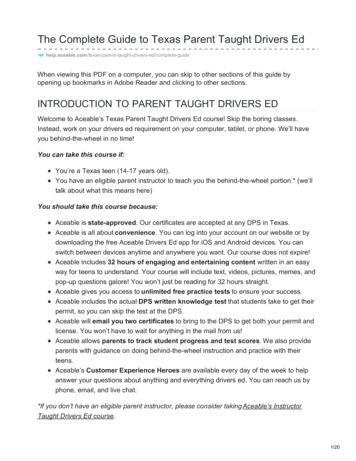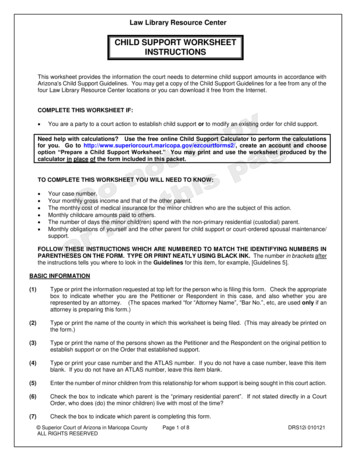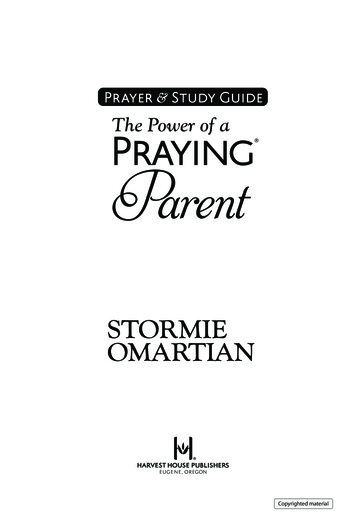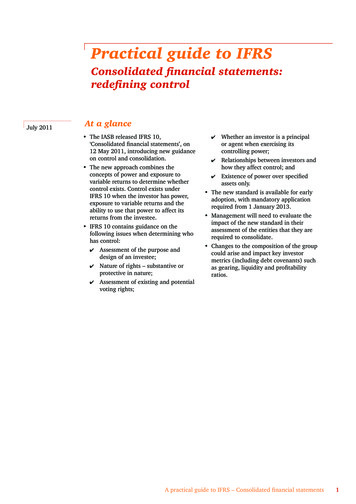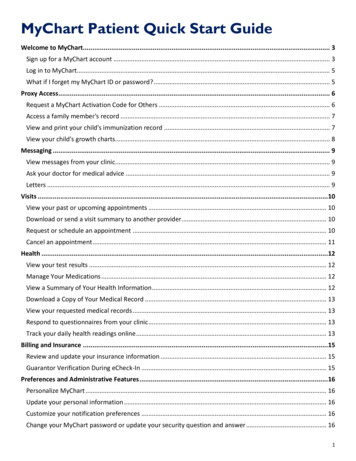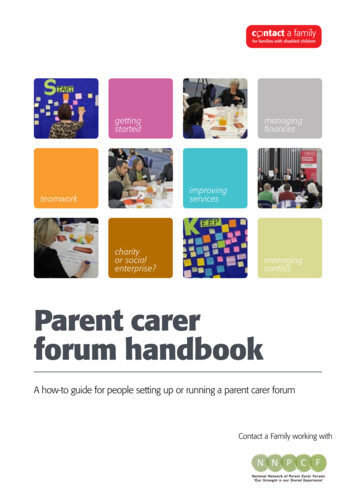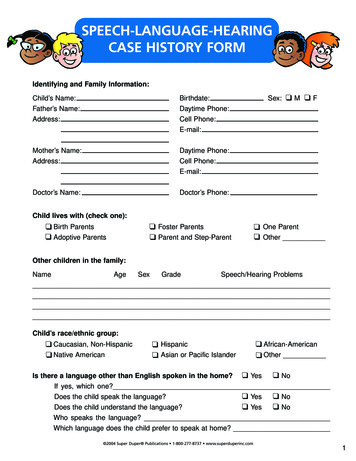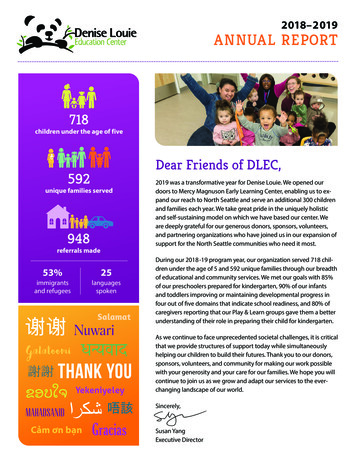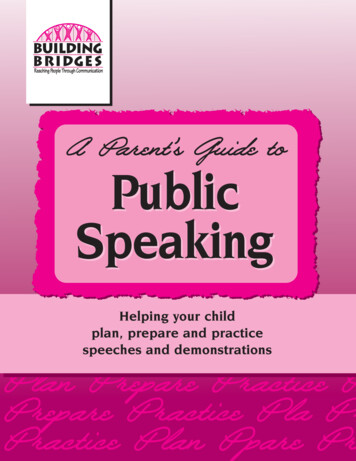
Transcription
A Parent’s Guide toPublicSpeakingHelping your childplan, prepare and practicespeeches and demonstrationsPlan Prepare Practice PPrepare Practice Pla PrPractice Plan Ppare Pr
Key QuestionsExperiential Learning Model"Experiential learning" is what distinguishes 4-H Youth DevelopmentEducation from many formal education methods. It involves providingopportunities for youth to practice what they are learning by sharingthe experience, reflecting on its importance, connecting it to real lifeexamples, and applying the knowledge that results to other situations.Examples ofsharing questions:(What happened?) What kinds of things have youbeen doing to organize yourspeech and get ready to deliverit? What is the hardest part aboutplanning your speech? What is something you reallyenjoy about putting a speechtogether?Examples ofprocessing questions:(What's important?) Why do you think it's importantto take the time to be wellprepared? What is something you wantto work especially hard toremember to do when you giveyour speech? What is something importantto keep in mind about beingevaluated or judged?Examples ofgeneralizing questions:(So what?) What do you think are the bestThe information and ideas in this manual have been designed with thismodel in mind. Your aim is to guide and support youth throughout theprocess. The following questions relate to the experiential learning model:things about your speech? Why is it important to be ableto have confidence in yourself? What are some things youwould like to do to improveas a public speaker?Examples ofapplication questions:(Now what?) How have you used your publicspeaking skills in other placesbesides contests and speakingevents? Describe a situation where it'sbeen helpful to know how toplan a speech and speak inpublic. What kinds of things might yoube able to do in the future withyour public speaking skills?
A Parent’sGuide toPublicSpeakingA note to adults:This manual, which is a part of the 4-H Youth DevelopmentBuilding Bridges: Reaching People ThroughCommunication program, has been designed specificallyfor parents and other adults who want to guide youth throughthe process of planning, practicing and presenting a speech ordemonstration. It can be used by adults to reinforce and supportwhat youth are learning as they work through the information inA 4-H Public Speakers Handbook.Communication as a Primary Life SkillThis project focuses on the life skill of communication with a particularemphasis on helping youth acquire confidence in their abilities to speakin public.
AcknowledgmentsWriters:Editor:Trisha Day, Universityof Wisconsin–Extension 4-H YouthDevelopment ProgramsWayne Brabender,University of Wisconsin–Extension 4-H YouthDevelopment ProgramsGreg Lampe,University of Wisconsin–Rock County, Dept.of Communication& Theatre ArtsDesign andProduction:Liz Kasper, NorthernDesign GroupSpecial thanks to the followingindividuals for providing valuablefeedback and suggestions during thedevelopment of these materials:Kathi VosSara LoppnowJulie LadwigJennifer KesselhonSara Jean BeachLiz MatzkeJenny FreemanAndy KoffmanMarilyn SurpriseNancy HerbisonLouise RobsonIrene BakkenJeri BezioSandy RauMarcia SpauldingTheresa WimannNancy FranzDebbie MoellendorfSue PleskacRene MehlbergChuck PrisselKandi O’NeilDeb IveyHolly KanengeiterBrownAnnette BjorklundJennifer TabkeSteve Wagoner
A Parent’sGuide toPublicSpeakingAs a parent, there is a great deal you can do to help yourchild make the most of public speaking opportunities. Justremember the 4 “P’s” so you can help your child succeed:Plan, Prepare, Practice and Provide support so your son or daughtercan develop the confidence and skills needed to be a good speaker.Table of ContentsHelp your child plan 2Help your child prepare 4Help your child practice 5Parent’s feedback form 6Provide support 7Handling Stress 8A Healthy Approach to Competition 94-H Youth Development Building Bridges Curriculum – 4-H Public Speaker's Handbook1
Parents often hear their kids protest, “I can’t think of anythingto give a speech about!” Instead of telling a child what youthink would make a fantastic topic for a speech, try a differentapproach. Help your son or daughter explore the following four typesof speeches he or she might want to give.PlanIt could be a speech to inform, explain, demonstrate orteach. What’s something you can do particularly well that other peoplemight like to know how to do, too? Think of your favorite hobby or recreational activity. Why do youenjoy it and what kinds of things are most interesting about it? Think about something you learned at school or in 4-H that younever knew before. How might you go about sharing thatinformation with other people? What are some other things you would like to be able to teachor explain to an audience?ReadIt could be a speech to persuade or convince.more about it!For more informationabout selecting atopic for a speech,check out page 2 inthe 4-H Public Speaker’sHandbook. Think of something you think is important. How can you encourageother people to become more aware of what needs to be done aboutit? What is something in our society or world that ought to be changed?How can you encourage people to do their part? Think of something you believe very strongly is either right or wrong.How can you get other people to agree with you? What is something else you would like to persuade or convinceother people to do or think?nalP24-H Youth Development Building Bridges Curriculum – 4-H Public Speaker's Handbook
It could be a speech to inspire or bring about anemotional response. Think of someone you admire a great deal because of somethingcourageous (or inspiring or unselfish) he or she has done. Whatcan other people learn from his or her example? Do you know anyone who has had to deal with a difficultobstacle in his or her life? What did that person do to overcomethe hardships he or she endured? How did other people help? What can people do to make this world a better place? What is a value or principle that guides your own life (love,kindness towards others, courage, etc.)? Why is this so important?It could be a speech to entertain. Imagine looking 50 years into the future. What might be thesame and what might be different? Think of someone (alive or dead, real or make-believe) youwould like to visit? What would it be like to spend time with thatperson? What would you like to say to or ask that person? Howdo you think he or she would respond? Have you had an interesting experience recently that otherpeople might enjoy hearing about? (Perhaps it was a trip orvacation, or maybe you had visitors from another country.) Whatmade that experience unique? What lessons did you learn? Instead of telling jokes, can you think of other things you couldtalk about to entertain people?Keysto successThe topic your child selectshas a lot to do with how wellhe or she will do preparing anddelivering the speech. One sureway to turn the experience intoa nightmare is for your child tochoose a topic that’s notappropriate. Be realistic about the timeit will take to researchthe topic and prepare anynecessary posters, charts orvisuals. Unless there will beplenty of time for followingthrough with a complicatedidea, it would be better tochoose something a bit lesstime consuming. Will your child have accessto the information andsupplies he or she will needto develop the speech? Is your child going to becomfortable with the topic—or is it something that he orshe might not really want totalk about? Will theaudience want to hear aspeech on that subject? Will you be able to help yourchild when needed?4-H Youth Development Building Bridges Curriculum – 4-H Public Speaker's Handbook3
PrepareHint:Even speakers who appear to be talking naturally andspontaneously have usually given a great deal of thought towhat they were going to say ahead of time. That’s why they’reable to stand up to speak feeling confident and in control. Here’s howyou can help.Focus on what to say about the topic.12Resist the urge to writethe speech for yourchild.Once you’ve helped yourchild select the topicand begin organizing thespeech, it’s time tostand back for a whileand give him or her achance to put together afirst draft. Remember—the speech will be muchmore effective if yourchild speaks in his orher own words ratherthan yours.3Ask your child to list two or three important ideas about the topic he orshe has chosen. (It’s only necessary to tell people what’s most importantabout the topic rather than trying to cover everything.)Help pick out a method of delivery.A speech can be read from a prepared text, a set of brief notes, or presentedfrom memory.A demonstration shows how to do something or explains the steps in aprocess. It might also include visual aids to help illustrate the processbeing discussed.An illustrated talk includes the use of props or visual aids to make it easierfor the audience to keep track of the information being presented.Help your child organize what to say.Think about how long the speech needs to be. Some speakers recommendusing 15% of that time on the introduction; 80% on the body of the speech;and 5% on the conclusion.Ask your child to mention a few things he or she already knows about thetopic in order to start making some plans for how to organize the speech.Help him or her decide whether additional information is needed and ifso where to find it. (The library? The Internet? A teacher or other expert?)eraperPReadmore about it!For moreinformation aboutplanning andorganizing a speech,check out pages4–9 in the 4-H PublicSpeaker’s Handbook.44-H Youth Development Building Bridges Curriculum – 4-H Public Speaker's Handbook
Practicing a speech will help your child develop confidence andpoise. You can help by providing constructive feedback. Justremember—being supportive depends both on what you sayand how you say it. Here’s how to help your son or daughter succeed:Practice Remind your child that good posture, a pleasant and confidentexpression and a neat, well-groomed appearance are important. Since eye contact is a must, encourage your child to look at theaudience and not to be afraid to smile! Vocal expression, gestures, facial expressions and posture reflectyour son or daughter’s personal style. He or she will make the bestimpression by acting as natural as possible rather than by usingphony or overly dramatic gestures and expressions. Encourage your child to speak naturally—as if he or she werehaving a conversation with the audience. There’s no need to shout,but on the other hand it’s frustrating not being able to understandsomeone who’s speaking too softly. Tell your child to stand still and avoid shifting from side to side.It’s okay to move around while speaking, but make sure to movedeliberately—rather than roaming from place to place.Readmore about it!For more informationabout practicinga speech, checkout page 15 in the4-H Public Speaker’sHandbook. Remind your child not to stuff his or her hands into pockets or claspthem together in front or in back. Try to hold them naturally at theside or rest them on top of the podium or lectern. Tell your child not to worry too much about making mistakes. Evenexperienced speakers slip up, stumble on a word or even forget whatthey intended to say.Hinrotl:e isn’t tordind you to review an formmnieerKeeput rath ve advice. Th ointbezicictiupcritconstru can help yo akingedivogeprsmnext pa s your child i eech.ehtnsopprogreo the sout the e you listen tmeach tiecitcarP4-H Youth Development Building Bridges Curriculum – 4-H Public Speaker's Handbook5
Public SpeakingParent’s Feedback FormWhat was said?Could beimprovedGoodExcellentCommentsCould beimprovedGoodExcellentCommentsCould beimprovedGoodExcellentCommentsDid the introductioncapture my attention?Was the main idea ofthe speech discussed?Was the speechwell organized?Did the conclusion sumup the main idea?How was it said?Eye contact andfacial expressionGestures andbody languageDid speaker seemrelaxed, confident?Did speaker usecorrect pronunciation?Did speaker usecorrect grammar?Was speaker easyto understand?Did speaker handlemistakes?Overall ratingComments andsuggestionsfor improvement64-H Youth Development Building Bridges Curriculum – 4-H Public Speaker's Handbook
Anyone who has ever had to speak in public knows that it canbe scary. Some of that tension can actually help maintainfocus and alertness, but too much of it can be a problem.Experienced speakers have learned to have confidence in theirabilities. Parents are in a good position to help their children developthis valuable asset.ProvidesupportPoint out what your child is doing right.People who feel relaxed and confident about themselves often do betterwhen they stand up to speak. While it’s only natural for parents to noticetheir children’s shortcomings, it’s a good idea to get in the habit ofrecognizing the positive as well. When listening to your child practice, be sure to comment onspecific things you like about the speech instead of dwelling onlyon what needs improvement. (“You really did a great job of introducingyour topic.”) Mention something about your child’s appearance and speechdelivery that others are bound to notice (“Your smile is so warm andfriendly, and your gestures look very natural.”) Mention the progress you’ve noticed and what a difference it hasmade. (“I’ve noticed how you’ve really worked on improving your eye contactand it’s really looking good!”)Hint:Remember that it takescourage to givea speech.Positive and constructivesupport fromfamily andfriends has alot to do withwhether a child will feelgood about the experience.Youth who areconstantlycorrected, criticized, orblamed for their mistakesmay have a harder timedeveloping confidence.Be constructive when you must be critical.edivorPtroppuSWhen you must point out mistakes and shortcomings, do so in a positivemanner. Instead of concentrating on what needs improvement, add acouple of encouraging comments as well. The “sandwich” approach is agood way to do this. Here’s how it works: Begin with a positive observation. “I really like how you introduced thefirst main point of your speech.” Make a suggestion about what needs to be improved. “I think youcould use another example to support that particular point.” Then add another positive comment. “It’s great the way you’ve introducedand developed the rest of the speech!”4-H Youth Development Building Bridges Curriculum – 4-H Public Speaker's Handbook7
Handling StressEncourage your child to find his or her own wayof handling stress and tension.Let your child know that even the most experienced speakers getnervous before walking out on the stage to speak. What’s importantis finding a way to handle those feelings. That’s why it’s a good ideato make sure your son or daughter has learned some healthy stressreduction and relaxation techniques ahead of time. Here’s a goodopportunity for you to share some of the things you do personallywhen you’re feeling nervous and uptight.Readmore about it!For more informationabout relaxationtechniques that cancalm jittery nerves,check out page 16 inthe 4-H Public Speaker’sHandbook.To memorize or not to memorize?Many people feel it makes a speech sound “canned” or “mechanical” torecite it from memory. It can also be stressful for a child to have to worryabout what will happen if he or she should forget something. So there isdefinitely good reason for discouraging word-for-word memorizationon the grounds that it puts tremendous pressure on a child.One option is to practice the speech as it’s been written until yourchild is completely familiar with it. Then use note cards to jot downwords and phrases that can be used as reminders.A healthy approach to competition.Hifonrtyo: uth toIt’s importanthy attitudesdevelop healtition. Theirabout competlled withlives will be fiere what theysituations whged anddo will be judmparisonmeasured in coer people do.with what othn be anCompetition caimulatingexciting and sthen handledexperience. Wit canconstructivelyto work hardmotivate youthttheir very besand put fortheffort.8If your child will be participating in a competitive event, most likely hisor her speech will be evaluated in terms of content and delivery. It’s achance to receive constructive feedback from judges and evaluatorswho are themselves experienced speakers. Help your child take a positive approach to constructivecriticism. Look for a way to use evaluation feedback to improvehis or her performance the next time. If you or your child disagree with the way the judge rated thespeech, keep in mind that people react to things differently andtheir likes and dislikes aren’t the same. Instead of putting all the emphasis on what the judge says,encourage your child to self-evaluate his or her speeches.Some children leave public speaking competitions feeling foolish andembarrassed because of low scores. Perceptive parents use theseopportunities to remind children there’s always something to begained by trying one’s best. Wise people know there’s much to belearned from “failures” because they provide opportunities to improveand to grow.4-H Youth Development Building Bridges Curriculum – 4-H Public Speaker's Handbook
Keep winning in perspective:Sometimes competition gets out of hand. The “winning iseverything” attitude can cause excessive stress for children ifthey believe a parent’s love and approval is at stake. Further,every parent has seen instances where other parents havepushed their children to win at all costs—in spite of what’s goodfor the child and sometimes at the expense of what’s ethical.Such conduct undermines the spirit of competition and severelyinterferes with what the child stands to gain from theexperience.The value of competition depends on the things youth arelearning about themselves. Here are some pointers for parents: Acknowledge the goals your child has set for him orherself. Let your son or daughter know that regardless ofthe outcome, you’re proud of him or her for making thedecision to be a competitor. Make sure your child knows that while you are hoping heor she will do well in the competition, you will still feelthe same way about him or her regardless of the judge’sdecision. Help your child develop a healthy approach to winningor losing by stressing the importance of doing one’s besteven if it ends up not being the best.Hint:When all issaid and done,it’s not what the judgesaysthat matters. Rather, theeffort your child has put intothe speech,as well as theprogress heor she has madeas a result of the experience,are what really make themost difference.4-H Youth Development Building Bridges Curriculum – 4-H Public Speaker's Handbook9
Notes104-H Youth Development Building Bridges Curriculum – 4-H Public Speaker's Handbook
Other booksin this seriesinclude:4-H Public Speaker's Handbook:A Youth's Guide to Preparing and Presenting Speeches and DemonstrationsIt's All in the Family:Source Book of Communication Activities, Projects and Other Thingsto Do TogetherCommunication Activities for 4-H Clubs andOther Youth GroupsCrazy about Books:Having Fun with a Reading CircleVoices from the Past:Listening to People with Stories to TellTeaching Resources for Youth Educators:Source Book of Activities, Projects, Handouts and Other Ideas for TeachingCommunication SkillsCreative Wordworking:Fun Ideas for Writers
University of Wisconsin-Extension, U.S. Department of Agriculture and Wisconsincounties cooperating. UW-Extension provides equal opportunities in employmentand programming, including Title IX and ADA.Issued in furtherance of Cooperative Extension work, acts of May 8 and June 30, 1914,in cooperation with the U.S. Department of Agriculture, Carl O’Connor, Director,Cooperative Extension Service, University of Wisconsin-Extension, Madison,Wisconsin, 53706.Produced by the Department of 4-H Youth Development, University ofWisconsin-Extension, 426 Lowell Hall, 610 Langdon St., Madison WI53703; phone 608-262-1067. If you need this material in an alternativeformat, please contact the program coordinator or the UWEX AffirmativeAction Office. This information is for educational purposes only. Reference tocommercial products or trade names does not imply endorsement by the CooperativeExtension Service or bias against those not mentioned.re Practice Plan PreparePractice Plaan Prepare Practice lanThis publication is available from your county University of Wisconsin-Extensionoffice or from:Extension PublicationsRoom B18, 45 N. Charter St.Madison, WI 53715Phone 877-947-7827Comm06 - A Parent’s Guide to Public Speaking
Guide to Public Speaking. Plan 2 4-H Youth Development Building Bridges Curriculum – 4-H Public Speaker's Handbook P arents often hear their kids protest, “I can’t think of anything to give a speech about!” Instead of telling a child what you think w
